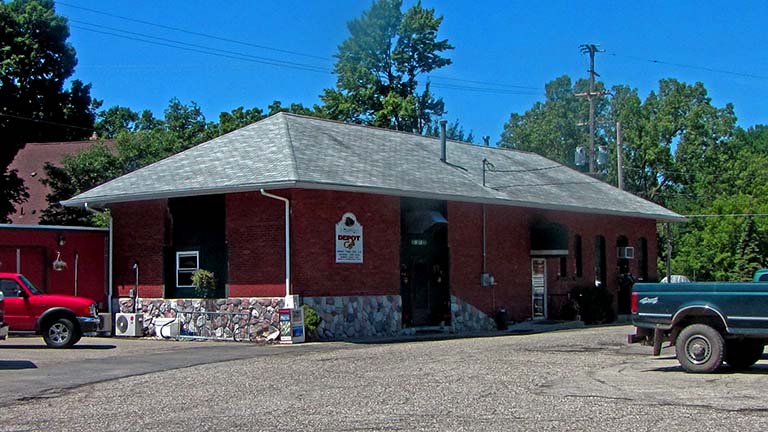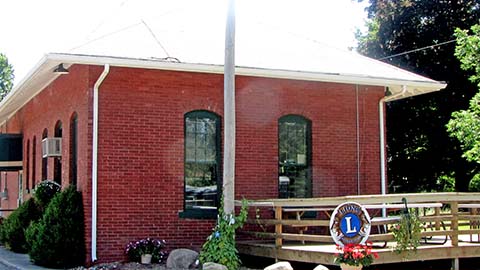

Transportation was a major challenge as the population of the United States grew and migrated west in the Nineteenth Century. The canals of the 1820s and 1830s were a tremendous improvement upon the early roads that were either mud trails or paved with timbers and, hence, often impassible. But no sooner had millions been invested by governments in canals, than the railroad came along with a much faster, cheaper and better way of moving people and products across the countryside. More than any other political event or technological improvement, railroads account for the populating of the Great Plains and for the development of an industrial nation that stretched from the Pacific to the Atlantic.
Interurban railways were a major new development that greatly improved the quality of life in the hinterlands of many large and small cities. Between 1893 and 1917, about 17,000 miles of interurban railway track was laid in this nation. Interurban rail networks were most dense in five states of the Northwest Territories: Illinois, Indiana, Michigan, Ohio and Wisconsin. The idea of using electricity to power a vehicle that would travel on rails developed toward the start of the Nineteenth Century, but was not perfected until the last decade. As early as 1834, a Vermont blacksmith, Thomas Davenport, demonstrated that miniature railroads could be electrically powered by a battery-fueled motor. In the 1840s, engineers in Scotland built a seven-ton, battery-powered electric powered vehicle that could operate on a railroad from Edinburgh to Glasgow. Alas, it could not attain a speed higher than four miles per hour. In 1851, Charles Page assembled a battery powered locomotive that could get to 19 miles per hour on trips from Washington, DC to Bladensburg, Maryland.
A major development occurred in the 1860s when dynamos or generators were developed that could power motors that would, in turn, drive a rail vehicle. This led to a great deal of experimentation in the United States, Germany and elsewhere. A major breakthrough occurred in 1887 when a Naval Academy graduate, Frank Julian Sprague, built an electrically powered street car line that operated successfully and profitably in Richmond, Virginia. Power was drawn from overhead wires. Today, we might overlook this great contribution of Sprague. However, prior to his electric street cars people had to get around cities on either their own horses or horse drawn vehicles. New York was an exception since a system of elevated steam train lines was being built there. Many cities quickly followed Richmond and granted contracts for city street car lines, most of them surviving into the 1940s.
that operated successfully and profitably in Richmond, Virginia. Power was drawn from overhead wires. Today, we might overlook this great contribution of Sprague. However, prior to his electric street cars people had to get around cities on either their own horses or horse drawn vehicles. New York was an exception since a system of elevated steam train lines was being built there. Many cities quickly followed Richmond and granted contracts for city street car lines, most of them surviving into the 1940s.
The early electric railways were limited to short distances within cities since there was no practical way to transmit the low voltage current street cars needed over long distances. This challenge was solved in 1896 with the development of substations. That is, high voltage current from an electrical source could be sent to substations where the electricity would be converted into the low voltage current used by the generator and motor in an actual street car. Another major development occurred two years later when Frank Sprague developed a system allowing the simultaneous multiple operation or two or more street cars linked together. Traction companies could assemble a train of street cars and one motor man in the front could call upon the power of several street cars linked together.
Street car lines generally operated within a rather densely settled city. Charles Henry, an Indiana lawyer and investor who later served in Congress, coined the term interurban for an electric line that would run from one city to a nearby city, passing through the country side. His inspiration was an electric railway used in the 1893 Columbian Exposition in Chicago. He also promoted interurban lines in Indiana and that state’s capital became the destination point for seven different lines. In 1893, one electric railway was completed from Sandusky to Norwalk, Ohio and another from Portland to Oregon City, Oregon. These were the first interurban lines constructed in the nation.
Following the election of President McKinley in 1896 and the Klondike Gold Strike of that year, the nation gradually came out of the economic recession that began in 1893. This led to an interurban railway building boom. The urban population was growing, but well over one-half the population lived in rural areas. Rural people wished to travel to nearby cities and the merchants in those locations wanted their business. Steam railroad lines were relatively expensive to build and operate so they charged substantial rates for passengers and freight, even for short distances. Often, one railroad dominated a local market so they could charge high rates.
Interurban lines were not so expensive to build and, compared to steam railroads, very cheap to operate. Interurban typically operated on street car lines in cities that had already been laid down. In the countryside, interurban lines placed their tracks alongside the muddy roads that went from one city to the next. For the most part, they did little grading. A steam train labored mightily to get up a grade of more than 1 percent. A single interurban car could go up a 10 percent grade. Steam railroads needed gradual curves and very substantial bridges to bear the weight of large trains. Interurbans were built with sharp curves and minimal bridges. A steam railroad passenger train ordinarily operated with a crew of six or more. An interurban car could operate with just one person. In many locations, interurban tracks paralleled steam lines but their fares were very much lower. Steam railroads tried to discourage the building of interurban railways and blocked their construction wherever possible.
For the most part, interurbans were built hastily with local capital. They met a need as rural people wished to go to neighboring towns. For the most part, interurban lines handled little freight but farmers could ship small amounts to local markets. They also handled local package freight, but with few exceptions, did not get the lucrative mail contracts that steam lines had.
Most interurban lines thrived in the years before World War I, but their future was not bright.
The nations’ railroads were so congested and ill-managed during that conflict that the federal government took them over. Vehicle manufactures saw an opportunity and very publically demonstrated that trucks could move freight over short and long distances. After World War I, the price of automobiles continued to decline thanks, in part, to Henry Ford’s consistent cutting of prices on his very basic and unchanging Model T. By the early 1920s, states—with help from the federal government—began paving intercity roads. Interurban lines found their business dropping rapidly. Very many interurban lines went out of business in the 1920s and the majority of those that survived that decade, quit in the Depression. Probably fewer than 1,000 miles of interurban line survived into World War I.
The Chicago, South Shore and South Bend Railroad, offering service from Chicago to South Bend is the only surviving interurban line, although a few miles of former interurban track have been purchased by other railroads.
The Grand Rapids, Grand Haven and Muskegon Railway was unusual for its financial security. There were local investors who helped build the line but the Westinghouse Electrical and Manufacturing Company, then a major manufacturer of electrical equipment, invested heavily in this line and in other one interurban that linked Wilkes Barre and Scranton Pennsylvania, the Lackawanna and Wyoming Valley Railroad. As was common for interurban lines, the GRGH &M used 3.3 miles of city street car lines in Grand Rapids and 3.3 miles of similar lines in Muskegon. In between, they build a substantial 29 mile roadbed that passed through what is now known as Marne. In addition, there was an 8 miles branch from the main line reaching Grand Haven. Two additional miles stretched the line to a resort known as Highland Park. The entire line opened for business on February 2, 1928. Most interurban strung their electric wire from inexpensive poles challenge their service in heavy weather. Having resource to substantial capital, the GR, GH & M used a more expensive but more reliable third rail system outside cities similar to the system used in modern subways.
Originally, a modest wooden depot was built in Marne but it was destroyed by fire in 1912. Since this was the era of great profits for interurban, the railway built an impressive brick depot that would be worthy of the Michigan Central or the Grand Trunk Western. Note that it has a bay facing the tracks so that the agent could see approaching interurban cars. The windows were designed in the stylish Italianate mode.
At look at the 1910 schedule shows hourly service from Grand Rapids to Muskegon with a connection at the Grand Haven branch for most every train. Interurbans were not rapid. The eight mile trip from Marne to downtown Grand Rapids took about 40 minutes, much of that time spent in street running in the large city. The entire 34 miles trip from Grand Rapids to Muskegon was carded for just under two hours.
By 1925, every interurban railroad in Michigan except the GRGH & M was in bankruptcy. The original owners of this line sold it to a Grand Rapids utility holding company in 1912. That firm spun off the rail line in 1926. Competition from automobiles and trucks made the rail line unnecessary. The firm failed and operation ceased on April 18, 1928. There were at least a couple of Michigan interurban lines that continued to operate for a few years longer. The one linking South Bend to Benton Harbor survived until 1934 and was, apparently, the last interurban to operate in the state.
The city was originally named Berlin because of the large number of Germans who settled here. However, some patriots felt that such names—and the study of German—was not appropriate during World War I. In early 1919, the name of the city was changed to Marne to commemorate the Second Battle of Marne. This September, 1918 battle outside Paris was the first time thousands of American troops participated in the Great War. It was also a turning point, helping the Allies to defeat the Germans. The name change must not have been universally popular since Marne remains in Berlin Township and the city’s annual summer fair still carries the name Berlin.
Date of construction: 1913
Architect: Unknown to me
Architectural Styles: Italianate windows
Use in 2011: One half is used by the local Lions’ Club. The other half is
the popular Marne Interurban Depot Café.
Website for Interurban Depot Café: http://www.polkapops.com/InterurbanDepot.html
State of Michigan Registry of Historic Sites:
National Register of Historic Places:
Photograph: Ren Farley; June 29, 2011
Description prepared: July, 2011